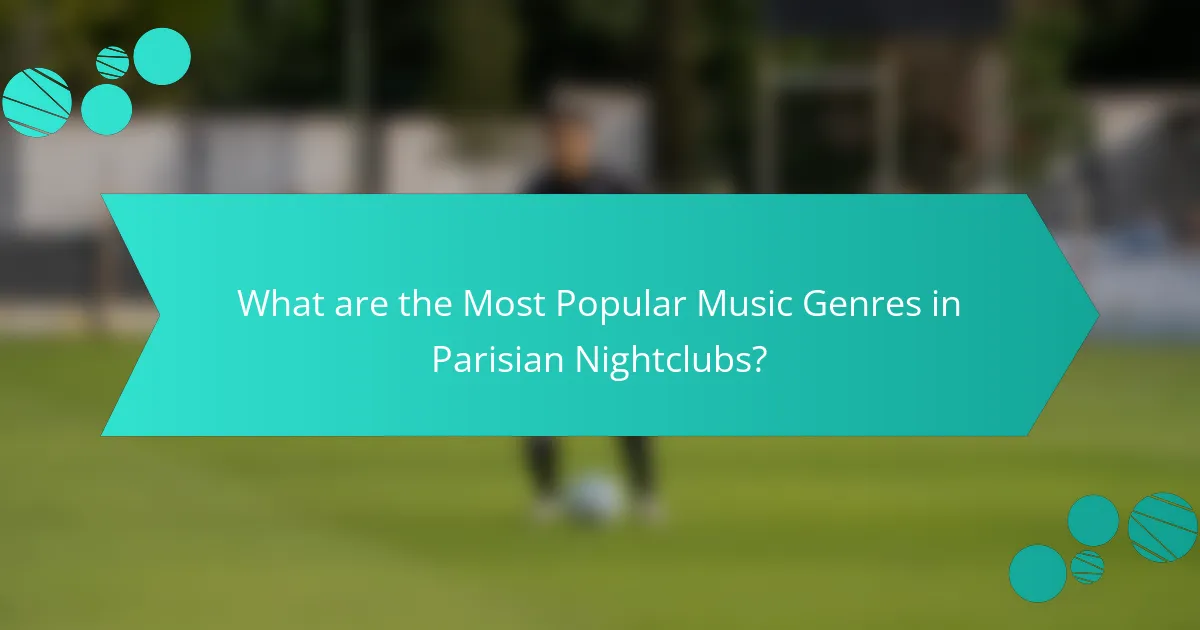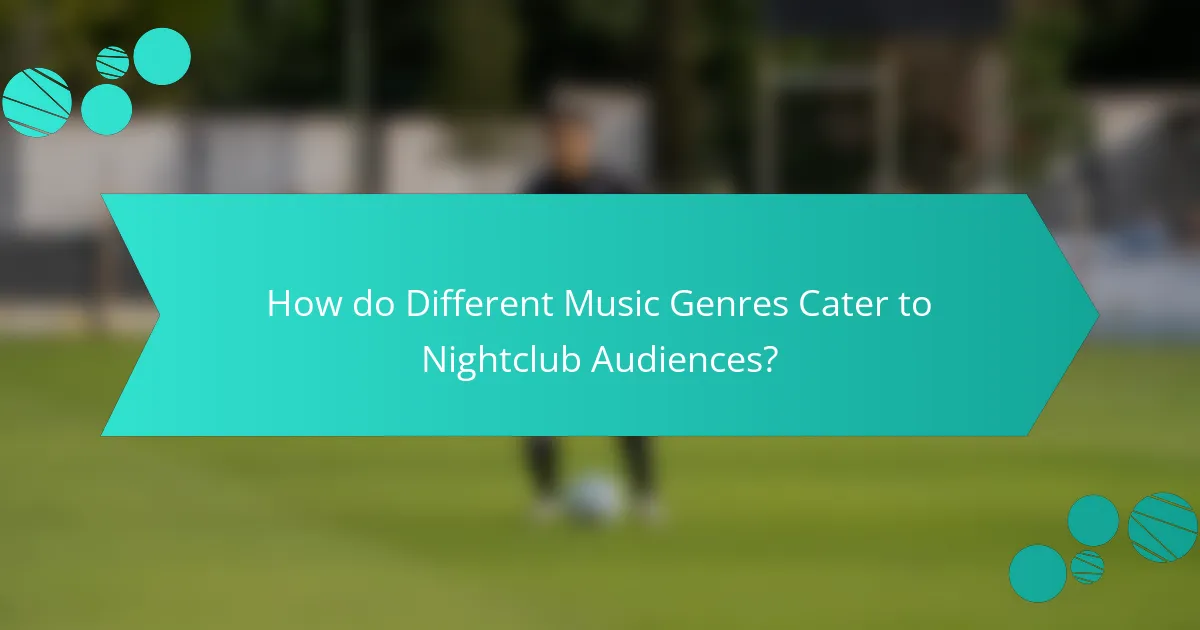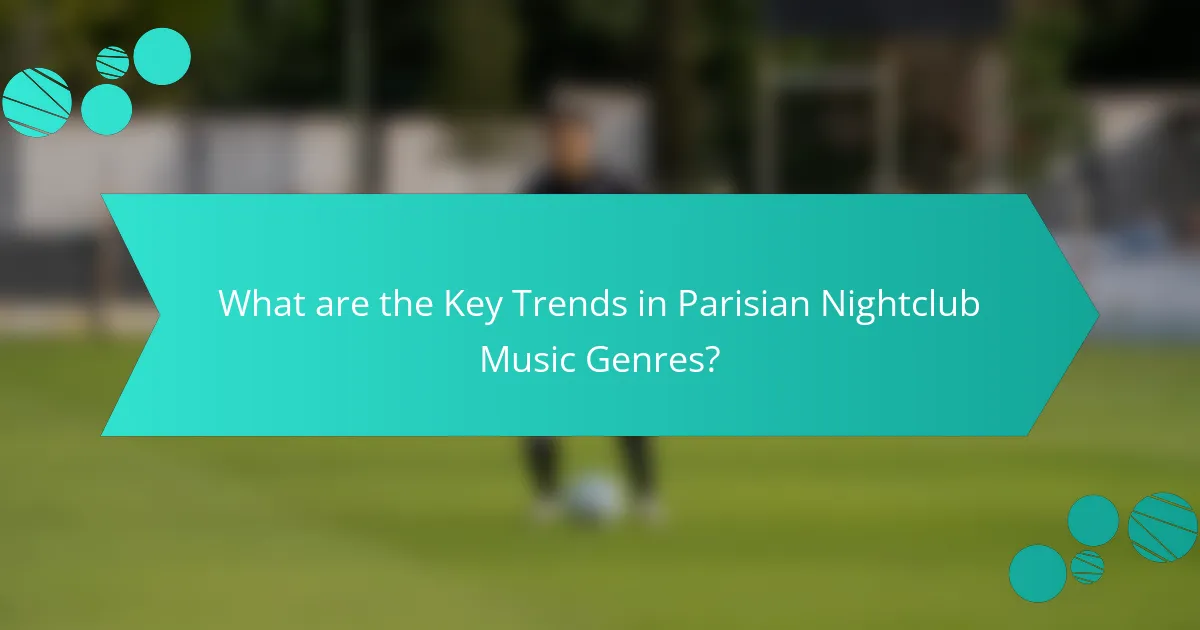The article explores the most popular music genres in Parisian nightclubs, focusing on electronic dance music (EDM), house, techno, and hip-hop. It highlights the dominance of EDM characterized by upbeat tempos, along with the appeal of house music’s deep basslines and soulful vocals. Techno’s minimalistic style and hip-hop’s rhythmic storytelling are also examined, reflecting their growing popularity among younger audiences. The article discusses how these genres create distinct atmospheres in nightclubs, catering to various demographics and enhancing the nightlife experience in Paris. Key trends, including the rise of deep house and global music influences, further illustrate the city’s diverse cultural landscape.

What are the Most Popular Music Genres in Parisian Nightclubs?
The most popular music genres in Parisian nightclubs are electronic dance music (EDM), house, techno, and hip-hop. EDM dominates the scene, characterized by its upbeat tempo and synthesized sounds. House music, with its deep basslines and soulful vocals, is also widely favored. Techno, known for its repetitive beats and minimalistic style, attracts a dedicated crowd. Hip-hop has gained significant traction in recent years, appealing to younger audiences. According to a 2022 survey by the Paris Nightlife Association, 70% of club-goers prefer EDM and house music. The vibrant nightlife in Paris reflects these genre preferences, showcasing local and international DJs.
How have music genres evolved in Parisian nightlife?
Music genres in Parisian nightlife have evolved significantly over the decades. Initially, jazz dominated the scene in the early 20th century, reflecting the city’s vibrant cultural exchange. In the 1960s and 70s, rock and pop music gained traction, influenced by global trends and local artists. The 1980s saw the rise of electronic music, particularly house and techno, as nightclubs began to embrace DJ culture. By the 1990s, hip-hop emerged as a prominent genre, resonating with the youth and reflecting social movements. Today, Parisian nightlife features a diverse mix of genres, including deep house, trap, and indie pop. This evolution mirrors broader societal changes and the city’s role as a cultural hub. Notable venues like Rex Club and Le Bataclan have adapted to these shifts, showcasing a range of styles and fostering new talent.
What historical influences shaped these genres?
Various historical influences shaped the music genres found in Parisian nightclubs. The emergence of jazz in the early 20th century significantly impacted these genres. Jazz brought improvisation and syncopation, which influenced subsequent styles. The post-World War II era saw the rise of electronic music, shaped by technological advancements. Additionally, the cultural exchange from African and Caribbean music enriched the local scene. The punk movement of the 1970s introduced raw energy and rebellion, shaping genres like rock and new wave. The globalization of music in the 21st century further diversified the genres present in Parisian nightclubs. Each of these influences contributed to the eclectic mix of sounds that define the contemporary nightclub experience.
How do cultural trends impact music genre popularity?
Cultural trends significantly influence music genre popularity. They shape listener preferences and drive the emergence of new styles. For example, the rise of social media has amplified genres like hip-hop and electronic dance music. Platforms like TikTok often dictate which songs become viral hits. Additionally, cultural movements can revive interest in older genres, such as disco or funk. Historical events, such as social justice movements, also impact music themes and styles. The blending of genres reflects cultural diversity and innovation. Overall, cultural trends serve as a barometer for the evolving landscape of music preferences.
Why are certain genres more prevalent in Parisian nightclubs?
Certain genres are more prevalent in Parisian nightclubs due to cultural influences and historical context. Paris has a rich musical heritage that shapes nightlife preferences. Electronic music, particularly house and techno, dominates the scene. This genre aligns with the city’s artistic and avant-garde spirit. Additionally, the presence of renowned DJs and music festivals boosts its popularity. Genres like hip-hop and pop also resonate due to their global appeal. Local artists often blend traditional French music with contemporary styles. This fusion creates unique sounds that attract diverse audiences. Overall, the nightclub scene reflects Paris’s dynamic cultural landscape.
What role do local artists play in genre popularity?
Local artists significantly influence genre popularity in Parisian nightclubs. They shape the music scene by introducing unique sounds and styles. Their performances attract local audiences and create a loyal following. This engagement fosters a sense of community around specific genres. Local artists often collaborate with DJs and producers, blending different musical elements. This collaboration leads to the evolution of genres and keeps them fresh. Additionally, local artists often perform at smaller venues, making music accessible to diverse audiences. Their grassroots efforts help elevate certain genres to mainstream recognition.
How does the nightclub atmosphere influence genre selection?
The nightclub atmosphere significantly influences genre selection by creating an environment that encourages specific musical styles. Factors such as lighting, decor, and crowd energy play a crucial role in this selection process. For instance, vibrant lighting and a high-energy crowd often lead to the choice of electronic dance music (EDM). In contrast, a more intimate and relaxed atmosphere may favor genres like jazz or acoustic music. Additionally, the time of night affects genre choice; peak hours typically feature upbeat tracks to maintain energy levels. Research indicates that clubs with a strong visual aesthetic tend to favor genres that complement their theme, enhancing the overall experience. Thus, the interplay between atmosphere and music genre is essential for optimizing the nightlife experience.
What are the defining characteristics of popular genres in Paris?
Popular genres in Paris include electronic, hip-hop, and house music. Electronic music is characterized by its use of synthesizers and digital production. It often features repetitive beats and a focus on rhythm. Hip-hop in Paris showcases lyrical storytelling and cultural expression. It frequently incorporates samples from various music styles. House music is known for its soulful vocals and deep basslines. It emphasizes a steady four-on-the-floor beat, creating a danceable atmosphere. Each genre reflects the vibrant nightlife and diverse cultural influences in Paris. The city’s clubs often blend these genres to create unique sound experiences.
What rhythms and beats are common in Parisian music genres?
Common rhythms and beats in Parisian music genres include 4/4 time signatures, syncopation, and swing. These characteristics are prevalent in genres like house, electro, and jazz. House music often features repetitive beats and basslines, creating a danceable groove. Electro incorporates synthesized sounds with driving rhythms. Jazz brings in complex rhythms, including swing and improvisation. Historically, these elements have shaped the vibrant nightlife in Parisian clubs. The combination of these rhythms creates an energetic atmosphere that defines the Parisian music scene.
How do lyrics and themes vary across genres?
Lyrics and themes vary significantly across music genres. Each genre often reflects distinct cultural, emotional, and social contexts. For example, hip-hop frequently addresses issues like social justice and personal struggles. In contrast, country music often explores themes of love, heartbreak, and rural life. Rock music may focus on rebellion and freedom, while pop typically emphasizes relationships and positivity. Jazz lyrics often delve into introspection and improvisation, reflecting the genre’s roots in personal expression. Electronic music, on the other hand, may prioritize beats and atmosphere over lyrics, focusing on the experience rather than storytelling. These variations highlight how music serves as a reflection of diverse human experiences across genres.

How do Different Music Genres Cater to Nightclub Audiences?
Different music genres cater to nightclub audiences by creating specific atmospheres and experiences. Electronic dance music (EDM) energizes crowds with its upbeat tempos and drops. House music promotes a continuous groove, encouraging dancing. Hip-hop offers a connection through lyrical storytelling and rhythm. Reggaeton incorporates infectious beats that appeal to diverse audiences. Each genre attracts unique demographics, influencing the nightclub’s vibe. For instance, EDM often draws younger crowds, while jazz-infused lounges may appeal to a more mature audience. This alignment of genre and audience enhances the overall nightclub experience.
What types of music genres attract different crowds?
Electronic dance music (EDM) attracts younger crowds, particularly in nightclub settings. This genre includes subgenres like house, techno, and dubstep. EDM events often feature vibrant light shows and energetic performances. Hip-hop draws a diverse audience, including urban youth and fans of rap culture. It is characterized by its rhythmic vocal style and beats. Rock music appeals to older generations who appreciate its guitar-driven sound and lyrical depth. Jazz attracts a more sophisticated crowd, often favoring intimate venues. Its improvisational nature appeals to music enthusiasts. Pop music, with its catchy melodies, attracts a broad demographic, including families and casual listeners. Each genre’s unique attributes cater to specific crowd preferences, shaping the nightlife experience.
How does age demographics influence genre preference?
Age demographics significantly influence genre preference in music. Younger audiences often gravitate towards genres like pop, hip-hop, and electronic dance music. These genres are characterized by upbeat tempos and contemporary themes. In contrast, older demographics tend to prefer classic rock, jazz, and blues. These genres often reflect nostalgia and established musical traditions. Research indicates that 18-24-year-olds primarily listen to pop and hip-hop, while those aged 35 and above favor classic rock and jazz. This trend is evident in nightclub playlists, where younger patrons dominate the dance floors with current hits.
What role does social media play in genre popularity among club-goers?
Social media significantly influences genre popularity among club-goers. It serves as a platform for music discovery and sharing. Users often post about their favorite genres and artists. This creates trends that can rapidly spread within communities. Platforms like Instagram and TikTok feature music-related content prominently. Viral challenges and dance trends can elevate specific genres. For instance, a popular dance trend can lead to increased plays of a particular song. Data shows that 70% of music listeners discover new music through social media. This highlights the platform’s role in shaping musical tastes and preferences among club-goers.
How do DJs and live performers adapt genres for the nightclub scene?
DJs and live performers adapt genres for the nightclub scene by blending various musical elements. They create remixes that incorporate popular tracks with unique beats. This ensures the music resonates with the audience’s energy. Performers often adjust tempo and rhythm to maintain a danceable atmosphere. They may also infuse local cultural influences into their sets. This practice enhances the connection with the audience. Additionally, DJs utilize technology to manipulate sounds in real-time. This allows for spontaneous creativity during performances. Adaptation is crucial for keeping the nightclub experience dynamic and engaging.
What techniques do DJs use to blend genres effectively?
DJs use several techniques to blend genres effectively. One common technique is beatmatching. This involves aligning the tempos of two tracks to create a seamless transition. Another technique is phrasing, where DJs mix tracks at the right musical phrases for a smoother flow. Key mixing is also essential; DJs match the musical keys of songs to avoid dissonance. They often use EQ adjustments to balance frequencies and maintain clarity. Looping is a technique that allows DJs to repeat sections of a track, creating space for blending. Additionally, layering elements from different genres can enhance the overall sound. These methods help DJs create a cohesive and engaging musical experience.
How do live performances enhance the experience of specific genres?
Live performances enhance the experience of specific genres by creating a unique atmosphere. They allow for real-time interaction between artists and the audience. This interaction fosters a sense of community and shared experience. Genres like jazz thrive on improvisation, which is best showcased live. Rock concerts often feature high energy, amplifying the emotional connection for fans. Electronic music events frequently incorporate visual elements, enhancing the overall sensory experience. Studies show that live music can increase dopamine levels, resulting in heightened enjoyment. Overall, live performances provide an immersive experience that recorded music cannot replicate.

What are the Key Trends in Parisian Nightclub Music Genres?
Key trends in Parisian nightclub music genres include the rise of electronic dance music (EDM), deep house, and techno. EDM dominates the scene with its energetic beats and festival culture. Deep house has gained popularity for its smooth melodies and soulful vocals. Techno, with its underground roots, continues to thrive in Parisian clubs. Additionally, there is a growing interest in Afrobeat and global music influences. These genres reflect the city’s diverse cultural landscape. Recent surveys indicate that EDM events draw large crowds, showcasing its significance in nightlife. The blend of traditional and contemporary styles also characterizes the music played in Parisian nightclubs.
How are emerging genres reshaping the Paris nightclub scene?
Emerging genres are significantly reshaping the Paris nightclub scene by introducing new sounds and cultural influences. Genres like techno, house, and trap are gaining popularity among club-goers. These genres attract diverse crowds, fostering a more inclusive nightlife atmosphere. Venues are adapting their music programming to feature these emerging styles. This shift encourages local and international DJs to showcase their talents. Additionally, clubs are experimenting with innovative visuals and immersive experiences. The rise of these genres has led to increased collaboration between artists and venues. Overall, emerging genres are revitalizing the Paris nightlife, making it more dynamic and engaging.
What new genres are gaining traction in Parisian nightclubs?
Genres such as afro house, minimal techno, and synthwave are gaining traction in Parisian nightclubs. Afro house blends African musical elements with house beats, creating vibrant dance music. Minimal techno focuses on stripped-down sounds, emphasizing rhythm and texture. Synthwave revives 1980s synth music, appealing to nostalgia and retro aesthetics. These genres reflect the evolving tastes of club-goers in Paris. The city’s nightlife is increasingly diverse, showcasing global influences. Recent events and festivals highlight these emerging styles. This shift indicates a broader acceptance of eclectic sounds in the Parisian club scene.
How do international influences affect local music trends?
International influences shape local music trends by introducing new styles and genres. Globalization facilitates the exchange of musical ideas across cultures. This interaction leads to hybrid genres that blend local and international sounds. For instance, Parisian nightclubs often feature a mix of electronic music and traditional French styles. Collaborations between local artists and international musicians further enhance this fusion. Streaming platforms allow global music to reach local audiences quickly. Events like music festivals showcase diverse influences, encouraging local artists to experiment. This dynamic creates a vibrant music scene that reflects both local heritage and global trends.
What are the best practices for enjoying music genres in nightclubs?
To enjoy music genres in nightclubs, immerse yourself in the atmosphere. Engage with the music by dancing and connecting with the rhythm. Choose a genre you enjoy to enhance your experience. Arrive early to secure a good spot for optimal sound and view. Stay hydrated to maintain energy throughout the night. Dress appropriately for the genre and venue to feel comfortable. Respect the DJ and fellow patrons to foster a positive environment. Familiarize yourself with the genre’s history to deepen appreciation. These practices enhance enjoyment and create memorable nightlife experiences.
How can club-goers choose the right venue for their preferred genre?
Club-goers can choose the right venue for their preferred genre by researching clubs that specialize in that genre. Each music genre often has specific venues known for hosting relevant artists and events. For example, electronic music is frequently featured in clubs like Rex Club and Concrete in Paris.
Additionally, checking event listings and social media can provide insights into upcoming performances. Reviews and ratings on platforms like Yelp or Google can also guide choices based on the experiences of other attendees. Understanding the venue’s atmosphere and layout is crucial, as some genres thrive in intimate settings while others require larger spaces.
Finally, asking friends or community members who share similar musical tastes can lead to valuable recommendations. These methods ensure that club-goers find a venue that aligns with their musical preferences.
What tips can enhance the nightclub experience for genre enthusiasts?
To enhance the nightclub experience for genre enthusiasts, attendees should immerse themselves in the music culture. Research the specific genre being played and familiarize yourself with its history and key artists. Dress appropriately to reflect the genre’s style, which can help you connect with other enthusiasts. Arrive early to secure a good spot and enjoy the atmosphere as the venue fills. Engage with the DJ or performers, as many appreciate feedback and interaction. Attend themed nights or events focused on your favorite genre for a more tailored experience. Lastly, consider joining online communities or social media groups dedicated to the genre to stay updated on events and meet like-minded individuals.
The primary entity of this article is the popular music genres in Parisian nightclubs. The article provides an overview of the dominant genres, including electronic dance music (EDM), house, techno, and hip-hop, highlighting their characteristics and the evolution of music in Parisian nightlife. It explores historical influences, cultural trends, and the role of local artists in shaping genre popularity. Additionally, the article discusses how nightclub atmospheres and demographics affect genre selection, as well as emerging trends and best practices for enjoying music in these venues. Overall, it offers a comprehensive guide to understanding the vibrant music scene in Parisian nightclubs.